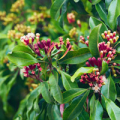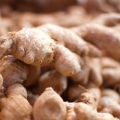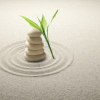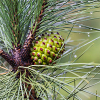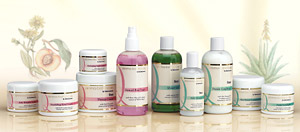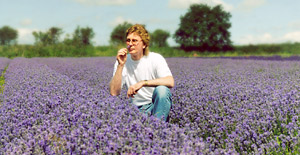Jasmine Absolute
 Along with rose otto and neroli, jasmine absolute is one of the most popular of all floral oils used in aromatherapy today.
Along with rose otto and neroli, jasmine absolute is one of the most popular of all floral oils used in aromatherapy today.
And with good reason. The divine rich, floral, and slightly fruity fragrance of Jasmine Absolute is ultra relaxing and uplifting to the emotional system as well as being a highly beneficial oil for the body, such as when it is used in skin care treatments.
Since time immemorial, all parts of the jasmine plant have been used for their therapeutic properties to treat a wide range of illnesses in many cultures around the world. So it should come as no surprise that aromatherapists find jasmine absolute invaluable when treating clients in modern times.
Physical description
Jasmine absolute is normally produced from a specific cultivar of jasmine, known botanically as Jasminum officinale L. forma grandiflorum. When growing wild, Jasminum officinalis is a slender, sub-erect or climbing shrub that is capable of growing from 1 to 5 metres in height, although plants cultivated for their oil are pruned and supported by a trellis, or posts and wires as employed in vineyards.
This deciduous vine has arching ribbed stems and branchlets encompassed by ovate, opposite, dark green leaves adorned with tubular, star-shaped flowers that grow either as an individual blossom or in clusters at the tips of branches. Buds are pink, and the beautifully fragrant white flowers typically measure up to 4 centimetres in diameter and are often tinged with pinkish-purple streaks.
Geographical sources
Jasmine officinalis is native to Afghanistan, northern Iran and Kashmir, and due to the endeavours of ancient Arab traders it spread to Egypt, Iraq, Java, Morocco, Philippines and Syria. The plant reached China via the Silk Road, and a mural painting discovered buried under lava in Pompeii suggests that the Romans cultivated jasmine as early as 50 to 100 years B.C.
Jasmine first arrived in Spain around 756 A.D. probably via the Arabs, and around 1600 A.D the Moors further established it, leading to the common name of “Spanish jasmine”.
The largest producers of jasmine absolute are Egypt, India and China, with smaller production taking place in Algeria, Italy, Morocco, Turkey and Tunisia. Although at one time France produced large quantities of the finest jasmine oil by means of enfleurage, the high cost of labour means that only tiny amounts are now produced this way, and the price for such material is astronomical.
Traditional uses
In rural India the juice from ground flowers is applied to wounds or sores, and a paste made from the ground root is used for labour pain and as a diuretic. In Ayurvedic medicine various parts of the plant are used to treat fever, abdominal problems, diarrhoea, redness and swelling of the eyes, sprains, fractures and wounds.
The Chinese use jasmine root to treat arthritis, headaches, insomnia, rheumatism and even pain caused by dislocated joints and broken bones, since the extract is believed to have anaesthetic properties. The flowers are used for conjunctivitis, dysentery, skin ulceration and tumours.
Since records began in Asia various species of jasmine have been used as a culinary ingredient and it is still used to make delicious teas, liqueurs, dairy desserts, candy and puddings. Jasminum officinale is the national flower of Pakistan and Tunisia.
Harvesting and extraction
In line with nearly all flowering plants, the timing is absolutely crucial when harvesting jasmine since the developing oil can be lost if the buds are collected either too soon, or too late. In Egypt, harvesting takes place between late August and mid October when the essential oil content is at its highest. The sweet fragrant jasmine flowers open early in the morning, therefore harvesting by hand begins at dawn and must be completed between 9.30am to 10.00am since the volatile oil evaporates rapidly. The work is skilled and back-breaking.
As with most oil-yielding flowers, once the buds begin to open it is a race against time to pick and transport them to the cool storage facilities at the distillery. This prevents any deterioration in the quality of the precious oil due to the loss of vital components. Jasmine absolute is obtained by solvent extraction, producing an orange-brown absolute with a rich, sweet, exotic-floral aroma that is both diffusive and long-lasting. When using jasmine absolute in aromatherapy, a little goes a very long way.
Benefits of jasmine absolute
Jasmine absolute has a relaxing effect on the body whilst stimulating the senses, which explains its renowned reputation as an aphrodisiac; it promotes a state of calmness and peace which helps to liberate sexual hang-ups allowing sexual energies to be released naturally. Research in 2002 confirmed that jasmine oil is a powerful relaxant that is an effective aid to promoting restful sleep. Test subjects who slept in rooms fragranced with jasmine slept more peacefully and reported higher afternoon alertness than having slept in a lavender scented room, or one with no fragrance at all. (1)
When a few drops of jasmine absolute are added to an unfragranced cream or lotion base, relief can be brought to hot, dry, irritated or sensitive skin, as well as assisting in the removal of blemishes and generally improving the complexion. Jasmine is also valuable as an aid to surviving emotional trauma, boosting confidence and self-esteem, and provides strength to those suffering from doubt and fear.
Jasmine absolute blends particularly well with most other floral oils, as well as with bergamot, cedar virginian, frankincense, geranium, grapefruit, lavender, lemon, mandarin, orange and sandalwood.
Copyright © Quinessence Aromatherapy Ltd 2019.
(1) Raudenbush, Wershing & Almeida. Wheeling Jesuit University in West Virginia, USA (Oct 2002). Effects of jasmine scent on sleep quality and post-sleep cognitive performance.

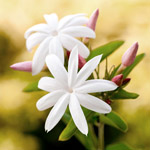 The word Jasmine, or Jessamine is derived from the Persian word ‘Yasmin’ which means either ‘fragrant flower’ or ‘gift of God’, according to interpretation.
The word Jasmine, or Jessamine is derived from the Persian word ‘Yasmin’ which means either ‘fragrant flower’ or ‘gift of God’, according to interpretation.